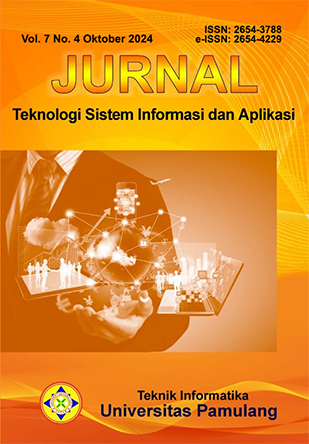Analisis Usability Aplikasi Sistem Database Pemasyarakatan Menggunakan Use Questionnaire dan Pengaruh Usefulness, Ease of Use, Ease of Learning terhadap User Satisfaction Menggunakan Regresi Linier
DOI:
https://doi.org/10.32493/jtsi.v7i4.40127Keywords:
Analysis; Usability; USE; Questionnaire; SDPAbstract
The Directorate General of Corrections (Ditjenpas) has developed various Information Technology services, one of which is the Correctional Database System (SDP) Application. Until now, the development of the SDP Application has not ensured that the system can provide maximum benefits in managing and improving the effectiveness of the correctional system. Therefore, it is necessary to conduct a usability analysis of the SDP application based on user perceptions. In this study, an analysis of the usability of the SDP application was carried out using the USE Questionnaire method. The USE Questionnaire is an instrument commonly used to measure the usability of an application with four parameters, namely usefulness, ease of use, ease of learning, and user satisfaction. This study involved 100 respondents. The results of the instrument test showed that all questions were valid and reliable, so they could be used in the study. The measurement results of the entire USE Questionnaire variable were obtained from the respondent's score of 9,647 and the maximum score in this aspect was 11,200, so the percentage of feasibility was 86.13%. Thus, it can be concluded that the level of usability of the SDP application is categorized as "Very Feasible" for use in the correctional process.
References
Dewi1, L. E., , Nyoman Trisna Herawati. SE., M.Pd., A., Erni, . Luh Gede, Sulindawati. SE., M.Pd., A., & . (2015). Analisis Pengaruh NIM, BOPO, LDR, dan NPL Terhadap Profitabilitas (Studi Kasus Pada Bank Umum Swasta Nasional Yang Terdaftar Pada Bursa Efek Indonesia Periode 2009-2013). Jurusan Akuntansi Program S1, 3(1).
Dwiyani Hadiwidjaja, R., & Fera Triani, L. (2009). Pengaruh Profitabilitas terhadap Dividend Payout Ratio pada Perusahaan Manufaktur di Indonesia. Jurnal Organisasi dan Manajemen, 5(1). https://doi.org/10.33830/jom.v5i1.214.2009
Fernanda, R. G., Suryadi, E., & Ali M, S. (2022). Pengukuran Usability Aplikasi Zoom Meeting Sebagai Media E-Learning Menggunakan Use Questionnaire. Jurnal Konseling Pendidikan Islam, 3(1). https://doi.org/10.32806/jkpi.v3i1.99
Ghozali, I. (2018). Aplikasi Analisis Multivariate Dengan Program IBM SPSS25. Badan Penerbit Universitas Diponegoro.
Lubis, B. O., Salim, A., & Jefi, J. (2020). Evaluasi Usability Sistem Aplikasi Mobile JKN Menggunakan Use Questionnaire. Jurnal SAINTEKOM, 10(1). https://doi.org/10.33020/saintekom.v10i1.131
Noor Aini Muflikhatun, M. (2024). Jurnal Teknologi Sistem Informasi dan Aplikasi Analisis Pengaruh Kualitas Website Simojang Berdasarkan Metode Webqual 4.0 dan Importance Performance Analysis (IPA) terhadap Kepuasan Pengguna. 7(1), 185–199. https://doi.org/10.32493/jtsi.v7i1.37847
Putra, Y. S. M., & Tanamal, R. (2020). Analisis Usability Menggunakan Metode USE Questionnaire Pada Website Ciputra Enterprise System. Teknika, 9(1). https://doi.org/10.34148/teknika.v9i1.267
Sufandi, U. U., Priono, M., Aprijani, D. A., Wicaksono, B. A., & Trihapningsari, D. (2022). Uji Usability Fungsi Aplikasi Web Sistem Informasi Dengan Use Questionnaire (Studi Kasus : Aplikasi Web Sistem Informasi Tiras dan Transaksi Bahan Ajar). Jurnal Pendidikan Teknologi Dan Kejuruan, 19(1).
Yahya, M. A., Wahyuningrum, T., & Adi Prasetyo, N. (2022). Usability Testing pada Prototype Aplikasi Mobile PlayKids Menggunakan USE Questionnaire. Journal of Applied Computer Science and Technology, 3(1). https://doi.org/10.52158/jacost.v3i1.160
Downloads
Published
How to Cite
Issue
Section
License
Copyright (c) 2024 Arif Rachman, Lussiana ETP

This work is licensed under a Creative Commons Attribution-NonCommercial 4.0 International License.
Authors who publish with this journal agree to the following terms:
- Authors retain copyright and grant the journal right of first publication with the work simultaneously licensed under a Creative Commons Attribution License that allows others to share the work with an acknowledgement of the work's authorship and initial publication in this journal.
- Authors are able to enter into separate, additional contractual arrangements for the non-exclusive distribution of the journal's published version of the work (e.g., post it to an institutional repository or publish it in a book), with an acknowledgement of its initial publication in this journal.
- Authors are permitted and encouraged to post their work online (e.g., in institutional repositories or on their website) prior to and during the submission process, as it can lead to productive exchanges, as well as earlier and greater citation of published work (See The Effect of Open Access).
Jurnal Teknologi Sistem Informasi dan Aplikasi have CC BY-NC or an equivalent license as the optimal license for the publication, distribution, use, and reuse of scholarly work.
In developing strategy and setting priorities, Jurnal Teknologi Sistem Informasi dan Aplikasi recognize that free access is better than priced access, libre access is better than free access, and libre under CC BY-NC or the equivalent is better than libre under more restrictive open licenses. We should achieve what we can when we can. We should not delay achieving free in order to achieve libre, and we should not stop with free when we can achieve libre.
This work is licensed under a Creative Commons Attribution-NonCommercial 4.0 International (CC BY-NC 4.0) License
YOU ARE FREE TO:
- Share - copy and redistribute the material in any medium or format
- Adapt - remix, transform, and build upon the material for any purpose, even commercially.
- The licensor cannot revoke these freedoms as long as you follow the license terms



_2020_-_7(2)_2024_-_Thumbnail.png)












